Keloids on the Body
Keloids can develop on any part of the body on individuals from any ethnic background. However, in general, keloids tend to occur classically on certain specific parts of the body due to some common medical and/or surgical reasons. At Rejuvence Clinic we offer a number of different treatment options and combinations for Keloid scars depending on where on the body they are located and what caused them.
Injectables start from £100
Laser Treatment starts from £200

What are keloids?
Keloids or keloid scars develop as a result of an overgrowth of collagen following cuts from skin breaks associated with acne, folliculitis (infected in-grown hairs) and chicken pox. They can also occur after surgery for a variety of reasons, infected or poorly healed body piercings and trauma.
Keloids are defined as raised scars that extend beyond the borders of the original cut or wound. They can grow to significant size and on any part of the body. They can also be associated with recurrent infection if associated with ingrown hairs. They can be very challenging to treat and are often associated with a significant rate of recurrence.
Who is prone to keloids on the body?
Specific ethnic groups have an increased risk of developing keloid scars. However, certain regions on the body are more prone to developing keloid scars irrespective of ethnic background. In general darker skin types (Asian and Afro-Caribbean) are at higher risk of developing keloid scars especially after surgery. However, keloids can occur in any ethnic group especially if associated with conditions such as acne.
Where do keloids commonly occur on the body?
Keloids can occur anywhere on the body. However, there are certain specific areas that are associated with specific causes. At Rejuvence Clinic, we are accustomed to treating patients who develop keloids on the chest, shoulders, and back due to acne. Keloids occurring on the abdomen and around the breasts are usually the result of surgery, especially cosmetic procedures such as tummy tucks and breast reductions. Keloids occurring on the pubic region in women are usually due to the development of ingrown hairs following shaving and are especially common in Asian and Afro-Caribbean women. We also commonly see keloids occurring on the back and chest, following surgery for moles, cysts and lipomas. Normally in these cases, the patients have not been advised about their risk for developing keloids as well as not being given specific instructions regarding after-care for surgical wounds.
What are the causes of keloids on the body?
There are a large number of causes for keloids occurring on the body. Different conditions result in keloid scar formation on different parts of the body in different ethnic backgrounds.
- Steroid Injection – £115 (up to 1ml)
- Steroid Injection – £175 (up to 2mls)
- Steroid Injection – £225 (up to 3mls)
- Steroid Injection w Target Cool – £155 (up to 1ml)
- Steroid Injection w Target Cool – £225 (up to 2ml)
- Steroid Injection w Target Cool – £275 (up to 3ml)
- Flurouracil (5FU) – £165 (per session)
- Flurouracil (5FU) & Steroid Injection – £245 (per session)
- Nd:YAG Laser – from £200 (per session)
- Cryotherapy – £150 (1 ampule) per session
- Cryotherapy w Target Cool – £200 per session
- Surgical Excision – POA
Acne
Acne on the chest, back and shoulders is extremely common amongst all ethnicities. In more aggressive and cystic acne conditions, many can be left with scars on the chest and back. Those with an increased tendency to develop keloid scars can go on to have active growing keloids that continue to get larger and hurt despite acne resolving.
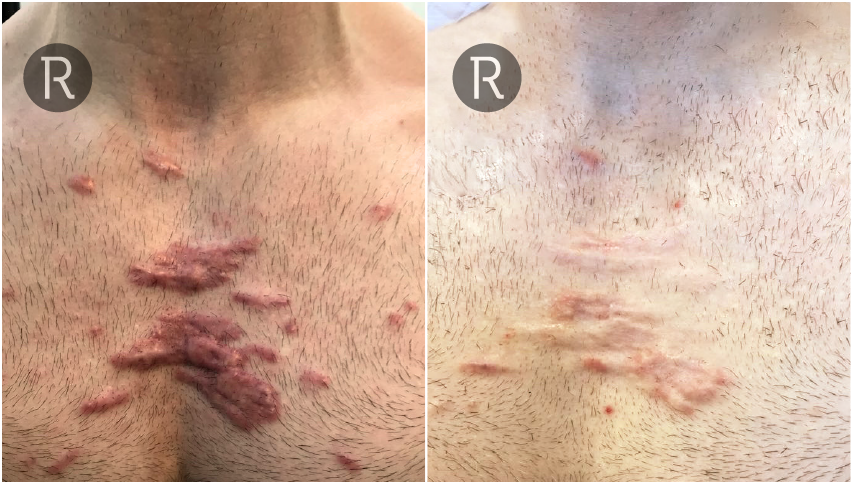
Symptoms
Acne associated keloid scars on the chest can be very itchy and painful. The scars are also raised off the surface of the skin and can cause pain and sensitivity especially when they are touched or brush against clothing. These scars can also be quite inflamed and in lighter skin types very red. Keloid scars from acne often take on a helical shape especially in the centre of the chest and on the shoulders. Over time individual scars can grow and join together.
Treatment Options
Treatment options for acne associated keloid scars include intralesional steroid injections in combination with YAG laser. Steroid injections help to break down the scar tissue and also help prevent continued growth of the keloid scar. Steroids also help with symptoms such as itching. YAG laser helps significantly with pain reduction and over time, with repeated treatment, the colour of the scars improve significantly, especially where they are quite inflamed and red. Where the keloid scars are quite stubborn it is possible to add in intralesional chemotherapy injections (5–FU). Surgery is rarely a good option and especially over the chest and shoulders. However, where the keloids have grown such that they are significantly visible through clothes and raise and extend upwards beyond the margins of their base, surgery may be the only option but must be followed up by steroid injections, YAG laser, and silicone gel strips to help prevent recurrence.

Flexible payment options for surgical treatment – 0% APR available. Spread the cost of your treatment today!
Terms and Conditions apply. *Acceptance subject to credit status.

Flexible payment options for surgical treatment – 0% APR available. Spread the cost of your treatment today!
Terms and Conditions apply. *Acceptance subject to credit status.
Side effects of treatment
Steroid injections are associated with skin atrophy (thinning of the skin) and hypopigmentation (whitening of the skin around the scar). Atrophy is due to break down of subcutaneous fat and thinning of the skin. This can result in scars dipping. In lighter skin types there can be bruising type discolouration as a result of this but there are no bruises per se. To avoid this we adjust the strength of steroid injected according to ethnic background of the patient and also always ensure we are only injecting into the scar itself and not around or below it. In darker skin types, especially Afro-Caribbean patients, steroids can block the production of melanin and result in the surrounding skin turning completely white. YAG Laser in conjunction with steroid injections helps to reduce the risk of steroid induced hypopigmentation. Hence we always encourage laser steroid combination treatments, especially for acne related Keloid scars.
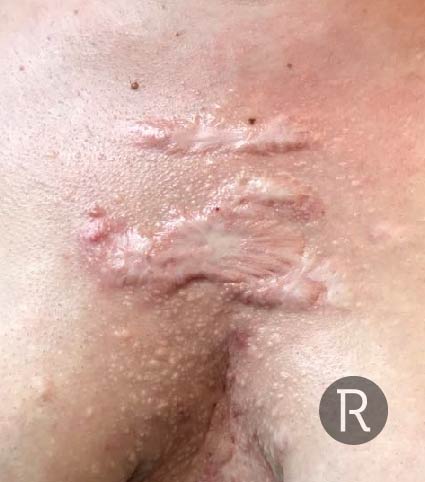
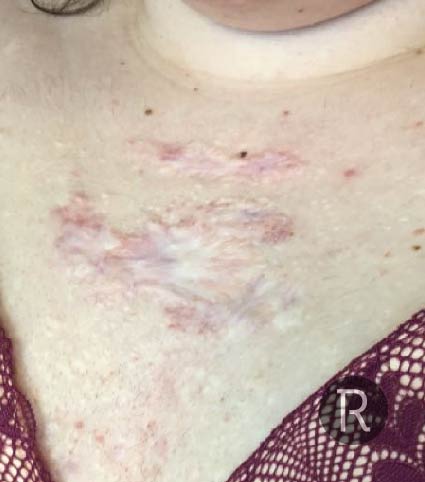
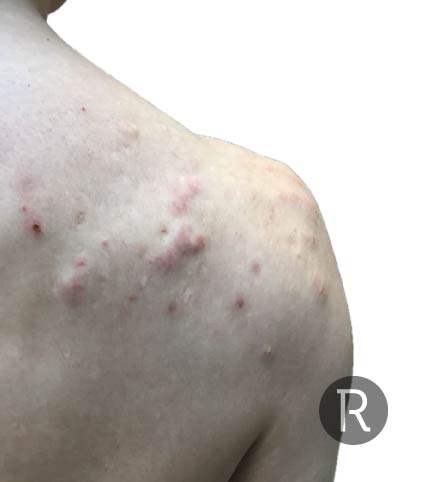
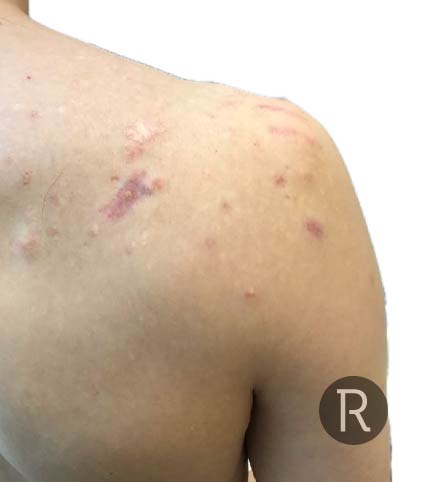
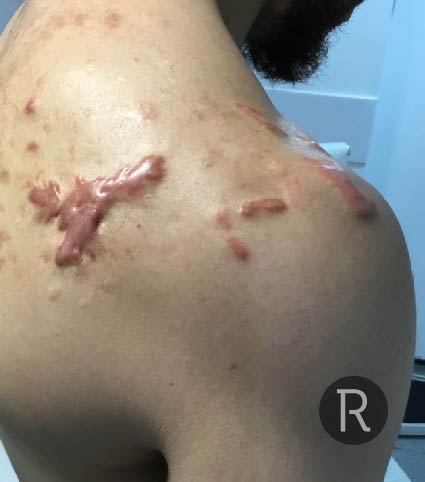
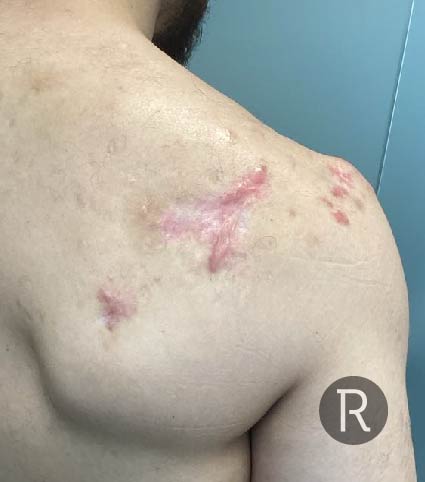
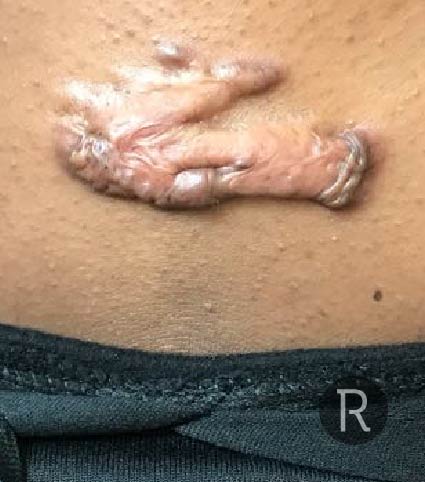
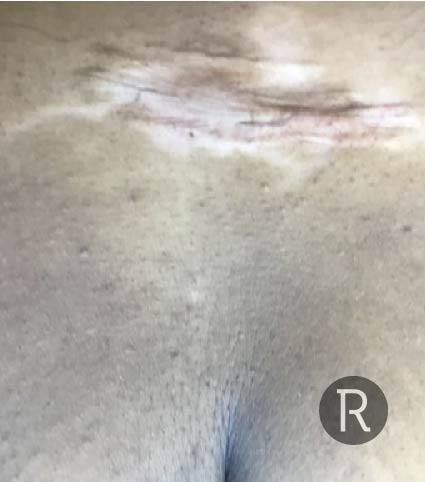
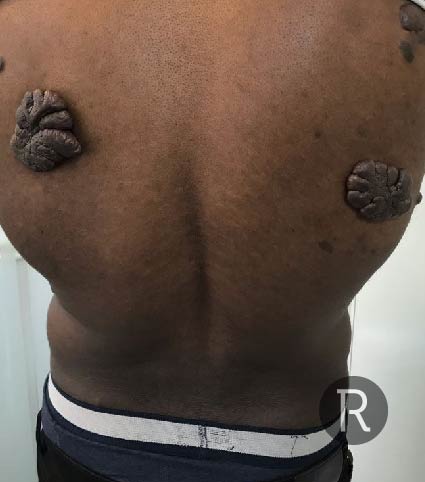
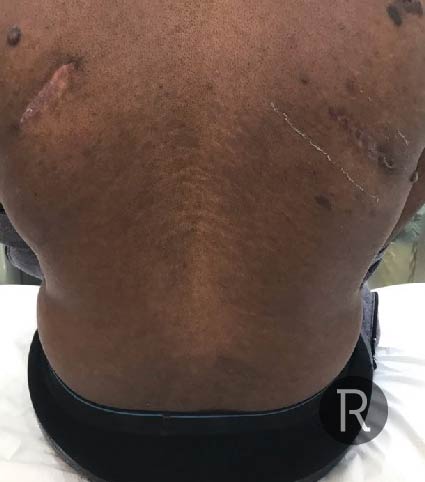
©Individual results may vary.
Realistic Expectations
The aim of treatment for acne related keloid scars should be to use a combination of treatments to improve the physical symptoms and aesthetic aspects of the scar. In general, we advise our patients that they can expect both pain and itching to improve significantly. Regarding the aesthetic aspects of their keloid scar, they can expect the contour of the scar to improve and in many cases, completely flatten out.
Regular treatment with YAG laser will help to improve colour mismatch, especially when the scars are very red. However, it is extremely important to understand that the scars will not completely disappear and it is extremely common for there to be some element of recurrence of symptoms months to years following the completion of treatment. We advise all our clients to stay in touch with us and notify us as soon as possible of the signs of any mild recurrence so we can offer small treatment options that can keep your keloid scar under control.
- Steroid Injection – £115 (up to 1ml)
- Steroid Injection – £175 (up to 2mls)
- Steroid Injection – £225 (up to 3mls)
- Steroid Injection w Target Cool – £155 (up to 1ml)
- Steroid Injection w Target Cool – £225 (up to 2ml)
- Steroid Injection w Target Cool – £275 (up to 3ml)
- Flurouracil (5FU) – £165 (per session)
- Flurouracil (5FU) & Steroid Injection – £245 (per session)
- Nd:YAG Laser – from £200 (per session)
- Cryotherapy – £150 (1 ampule) per session
- Cryotherapy w Target Cool – £200 per session
- Surgical Excision – POA
Chicken Pox Scars
Scabbed chicken pox lesions can leave quite marked scars. In keloid prone individuals, especially those from Asian and Afro-Caribbean backgrounds, chicken pox scabs can develop into Keloid scars. This is more likely when the scabs are very itchy and take longer to heal from repeated scratching and breaking of the skin. Often chicken pox occurs in childhood and the resultant Keloid scars are normally quite stable and static in nature. They can occur anywhere on the body. They are not associated with itching or pain as opposed to acne related Keloid scars. They are also normally less red and inflamed.
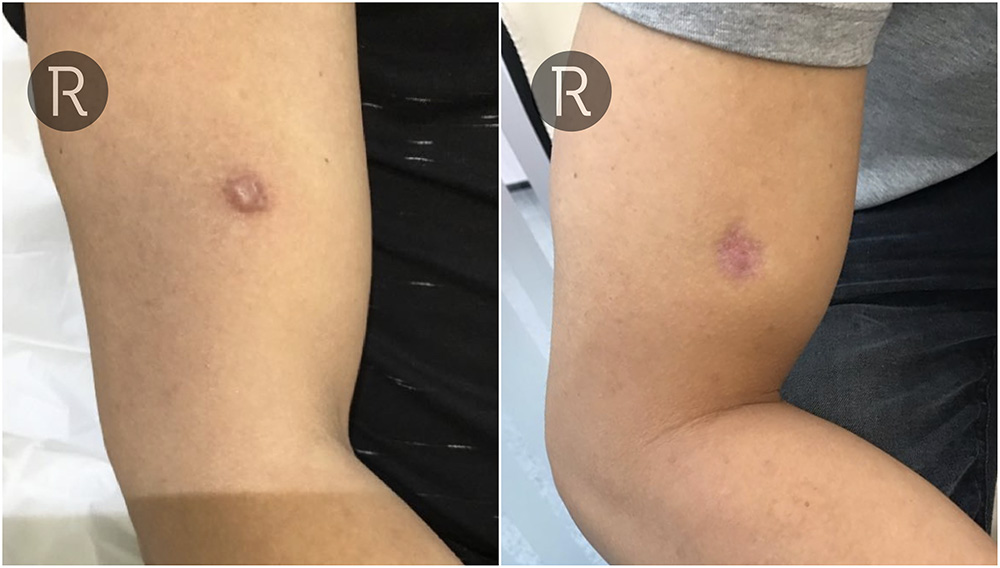
Treatment Options
The aims of treatment for chicken pox keloid scars are mostly aesthetic in nature as these scars are not normally associated with symptoms such as pain or excessive itching. Intralesional steroid injections can help break down scar tissue and quickly flatten them out. When combined with YAG laser the colour of the Keloid scars is also improved. Surgery is normally ill advised as improvements in scar contour and colour can be relatively easily achieved with non-surgical treatment approaches.

Flexible payment options for surgical treatment – 0% APR available. Spread the cost of your treatment today!
Terms and Conditions apply. *Acceptance subject to credit status.

Flexible payment options for surgical treatment – 0% APR available. Spread the cost of your treatment today!
Terms and Conditions apply. *Acceptance subject to credit status.
Realistic Expectations
Chicken pox keloid scars classically occur on the shoulders and usually result from excessive itching during the scabbing phase. With a combination of steroid injections and YAG laser it should be possible to get the scars flat. From our experience at Rejuvence Clinic we have found that reduced amounts of steroid should be used to avoid ‘pitting’ (atrophy) with more of a reliance on YAG laser. Improvements in colour can be achieved but require time and are the result of cumulative YAG laser sessions.
Ingrown hairs and keloids
Asians and Afro-Caribbean ethnicities (skin types IV-VI) are especially prone to ingrown hairs following shaving. Following shaving, thick and especially curly hairs, can become ingrown and result in irritation and inflammation causing folliculitis. Folliculitis can be complicated by infection leading to itching and blistering. Subsequent breaks in the skin can lead to the development of Keloid scars. The continued persistence of ingrown hairs within the newly formed Keloid scars can trigger further irritation, inflammation and infection resulting in a vicious cycle that ultimately causes the keloid scar to worsen.
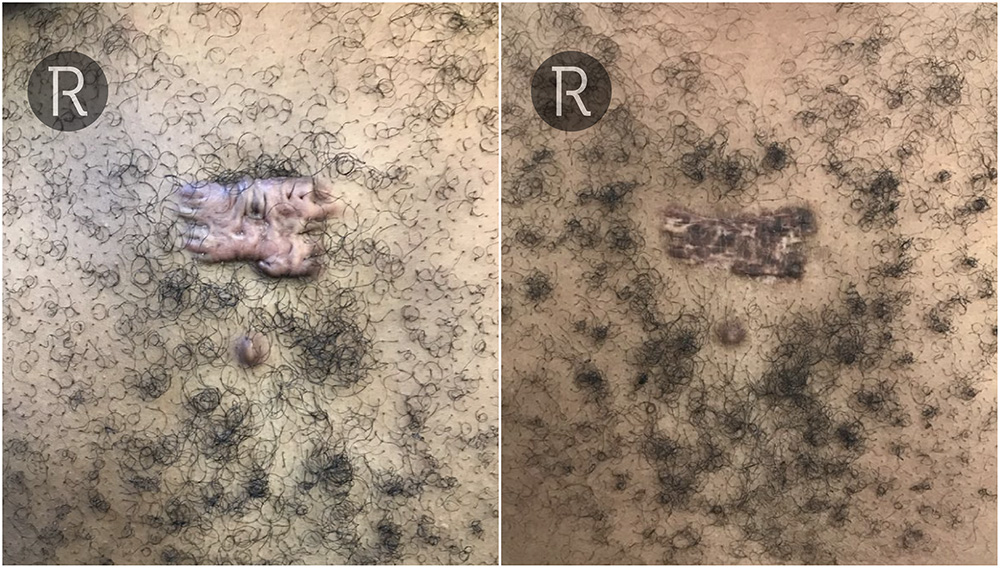
Keloids of this nature can develop on the back of the scalp also known as Acne Keloidalis Nuchae. Similar keloids can develop on the face and neck in men and women. Shaving pubic regions such as the armpits and bikini areas can also result in ingrown hairs, folliculitis and subsequently Keloid scars. These keloids can be very irritating, itchy and painful. They can also grow quite large and have a massive effect on confidence and self esteem directly impacting on intimacy with one’s partner
Treatment Options
Keloids associated with ingrown hairs are often complicated by infection. Hence prior to starting Keloid treatment it is extremely helpful to start preventative antibiotics. This can help to treat and prevent any concurrent infection which in turn makes Keloid treatment easier and more effective.
As with keloids occurring on other parts of the body intralesional steroid injections are first line and help to break down scar tissue quickly as well resolve itching and irritation. Ingrown hairs are the primary cause for the development of keloids in the pubic regions and hence combination with YAG laser is essential. Multiple sessions of YAG laser will help to destroy hair follicles within and around the Keloid. This will reduce the frequency of infection and prevent further progression of the Keloid scars. With larger keloid scars intralesional chemotherapy (5-FU) injections can help to reduce them further alongside steroids and laser treatment. Although recurrence rates are quite high Surgical removal of keloids should be considered where they are quite large and take on a pedunculated shape that is not going to be very responsive to a solely non-surgical approach. However, any surgery should be followed up with a series of steroid injections and YAG laser hair removal of the entire area to adequately reduce recurrence rates. We advise all our clients to stay in touch and inform as soon as they notice any evidence of recurrence.

Flexible payment options for surgical treatment – 0% APR available. Spread the cost of your treatment today!
Terms and Conditions apply. *Acceptance subject to credit status.

Flexible payment options for surgical treatment – 0% APR available. Spread the cost of your treatment today!
Terms and Conditions apply. *Acceptance subject to credit status.
- Steroid Injection – £115 (up to 1ml)
- Steroid Injection – £175 (up to 2mls)
- Steroid Injection – £225 (up to 3mls)
- Steroid Injection w Target Cool – £155 (up to 1ml)
- Steroid Injection w Target Cool – £225 (up to 2ml)
- Steroid Injection w Target Cool – £275 (up to 3ml)
- Flurouracil (5FU) – £165 (per session)
- Flurouracil (5FU) & Steroid Injection – £245 (per session)
- Nd:YAG Laser – from £200 (per session)
- Cryotherapy – £150 (1 ampule) per session
- Cryotherapy w Target Cool – £200 per session
- Surgical Excision – POA
Side effects of treatment
Keloid scars associated with ingrown hairs in the genital areas can be very dense and require large doses of intralesional steroid to soften and break them down. However, these patients are very susceptible to marked hypopigmentation of the scar and surrounding areas. YAG Laser treatment in tandem with steroids injections can help to mitigate against this. Once established the hypopigmentation is not permanent but can take months to improve. Often applying tacrolimus ointment to the affected areas every night can help to improve the loss of pigment. Surgery is associated with a high recurrence rate in the genital area and it is essential that surgery is backed up with non-surgical preventative measures. Continued shaving, epilation and/or the use of hair removal creams will often flare up the Keloid and hence should be avoided. We always advocate a series of YAG laser hair removal sessions alongside such treatments.

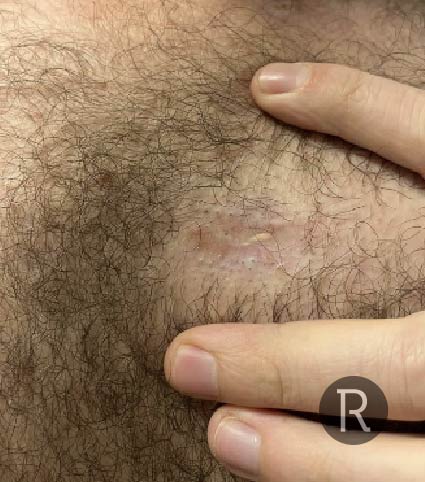
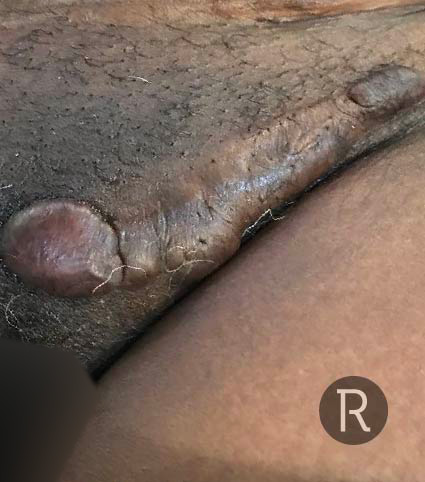
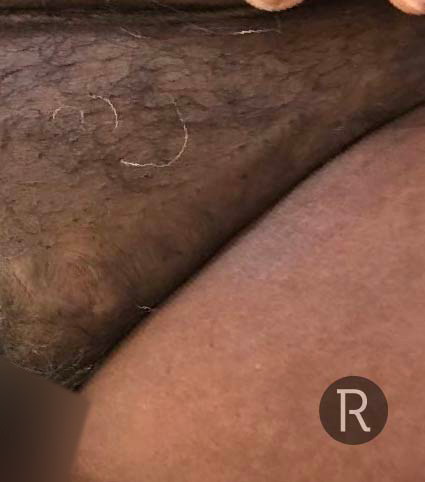
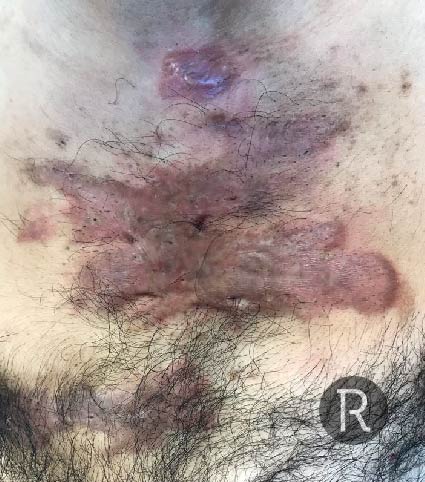
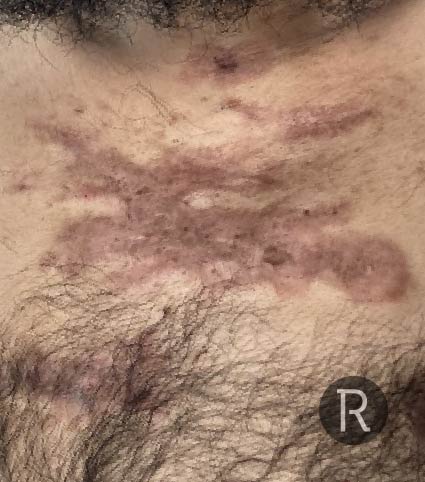
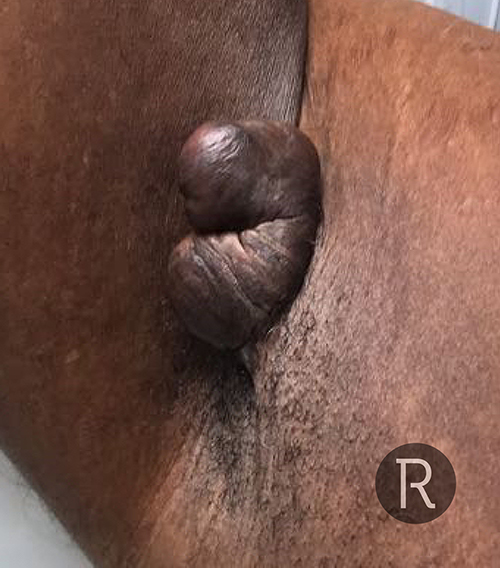
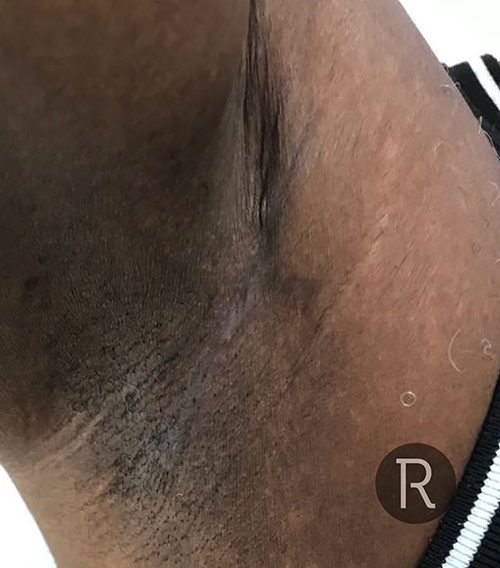
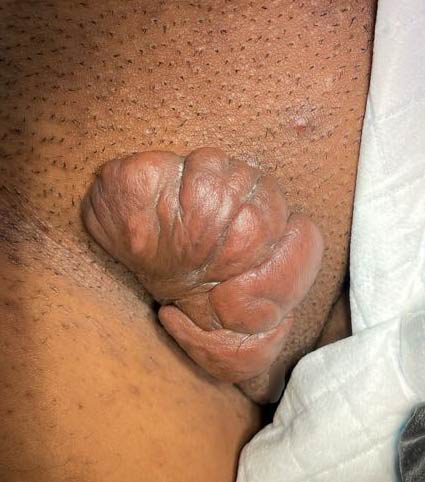
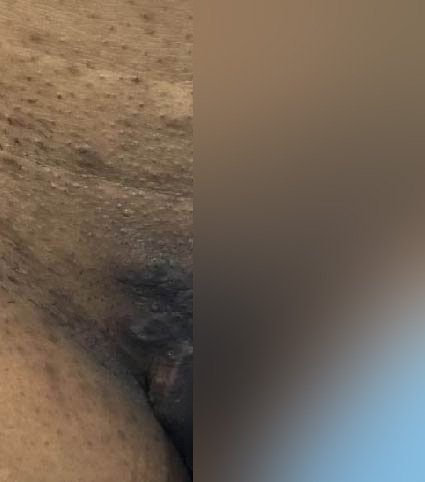
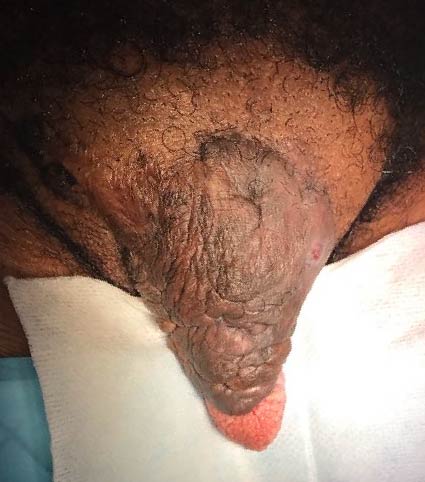
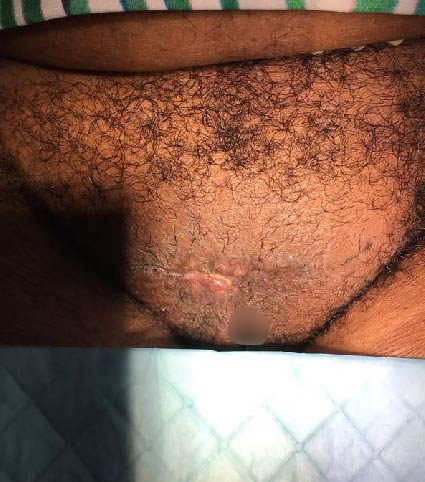
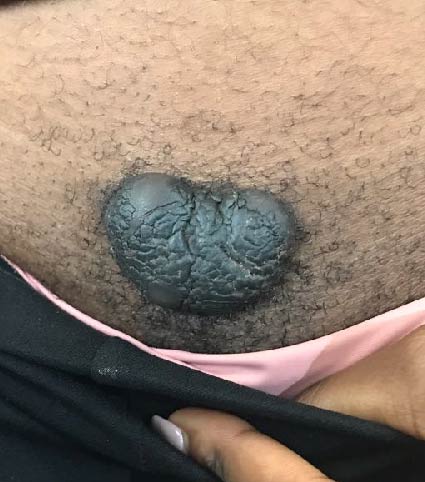
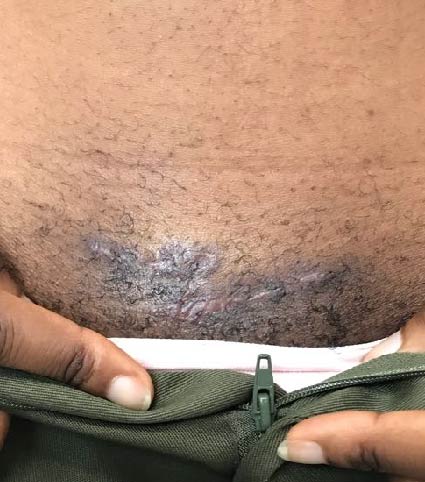
©Individual results may vary.
Realistic Expectations
From our experience at Rejuvence Clinic we have found that you can expect to be able to achieve an almost completely flattened Keloid scar especially where laser treatments have been maintained. Colour can also improve quite radically with the help of YAG laser. Appropriate Surgical candidates can also expect an excellent result as along as appropriate aftercare is adhered to.
Body Piercings
Poorly administered piercings and infected jewellery can result in the development of keloid scars at the site of body piercings. Earrings can cause distressing keloid scars to develop and are very well documented. However, piercings on the chest and belly button can also be associated with the development of keloid scars, especially when there are complications associated with the piercing itself or the piercings become infected. These keloid scars can be quite itchy in nature and continue to grow. When the piercings are taken out, the keloid scar can grow further. However, if the piercings remain in situ, they can sometimes become embedded in the growing keloid. keloid scars associated with body piercings are more common in those who are more prone to keloid scarring, namely Asian and Afro-Caribbean ethnic backgrounds. However, they can also occur in other ethnic backgrounds, especially those of North African and or Mediterranean descent.
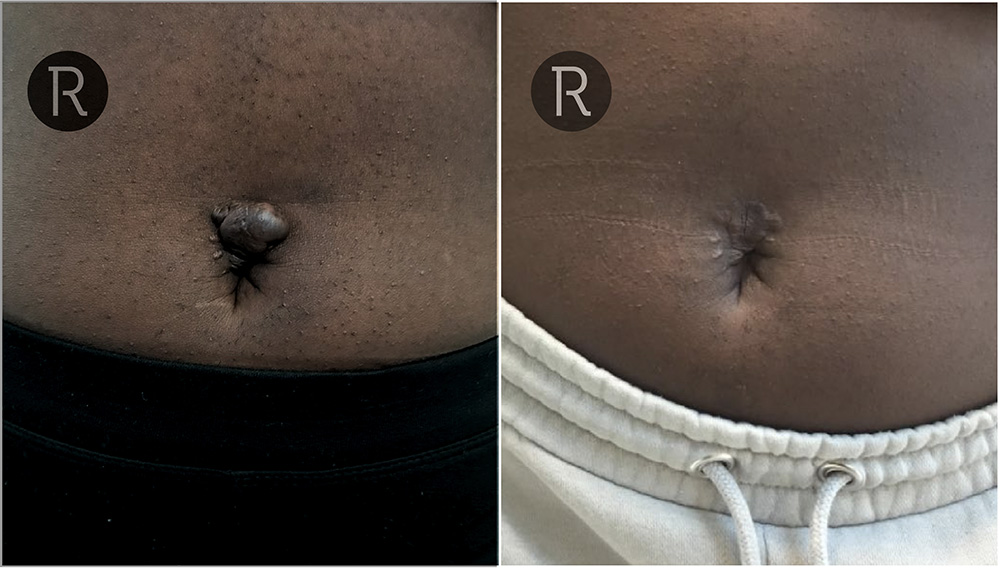
Treatment Options
In the first instance, we normally advise all our clients to remove the piercing jewelry if it is still in situ as it is likely to only continue to aggravate the keloid scar irrespective of the treatment recommended. First line treatment is normally with intralesional steroid injections. The steroid helps to break the scar down as well as reduce symptoms of itching and prevent further growth at least temporarily. From our experience at Rejuvence Clinic, these types of keloid scars are not as dense and thick as keloid scars associated with chronic inflamed medical conditions, such as acne or ingrown hairs. As a result, they are quite responsive to steroid treatment. In lighter coloured skin types there can be a significant amount of redness associated with the keloid scars and this normally benefits from improvement with YAG laser. Surgical removal of these keloid scars can be quite difficult, especially around the belly button. In cases where the keloid scars have significantly raised off the surface of the skin, surgery may be a better option.
This is particularly the case with keloids occurring following piercings on the chest. However, it is extremely important that any surgical treatment is followed up with a series of steroid injections to prevent new keloid recurrence, and if necessary even YAG laser. Following the initial follow-up series of steroid injections, those with very aggressive, keloid forming tendencies may even need intralesional chemotherapy injections such as 5-FU. Immediately following surgery. We also advise early application of silicon gel strips such as the Embrace Scar Sheet and following steroid and/or laser treatment we also advise the use of a steroid strip. Overall excellent results are possible.

Flexible payment options for surgical treatment – 0% APR available. Spread the cost of your treatment today!
Terms and Conditions apply. *Acceptance subject to credit status.

Flexible payment options for surgical treatment – 0% APR available. Spread the cost of your treatment today!
Terms and Conditions apply. *Acceptance subject to credit status.
Side effects of treatment
As already mentioned, keloid scars from piercings over the chest or belly button are less dense than keloids associated with chronic inflammatory medical conditions, such as acne and ingrown hairs. Hence the dose of steroid used, especially when in combination with laser treatment, should be reduced. Otherwise, the keloid scar can break down very quickly and patients can subsequently develop burns following any combination treatments with laser. This is even more significant in those with lighter skin types and from North African and Mediterranean ethnicities. Afro-Caribbean patients can develop hyperpigmentation in and around the keloid scars following intralesional steroid injections. This can be mitigated when adjuvant YAG laser treatment is also used. If hypopigmentation has developed, it is recommended to use Tacrolimus ointment every night for a period of three months in an attempt to reverse this. Keloid scar recurrence rates are relatively high following surgery. We only recommend a surgical approach for keloid scars developing following chest piercings. Belly button piercings are more challenging and we would normally recommend a non-surgical approach.
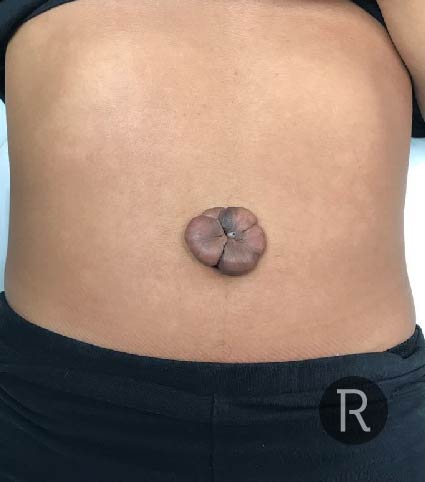
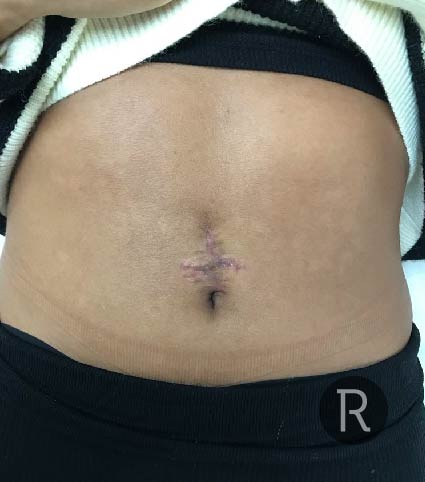
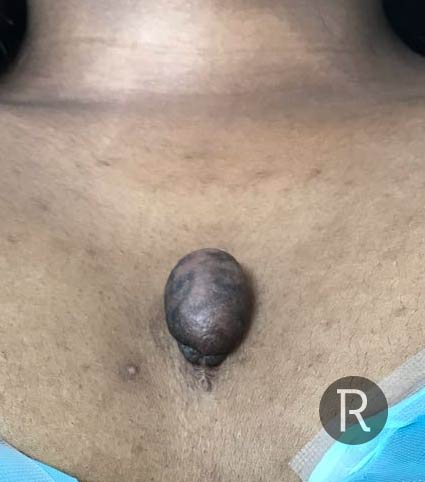
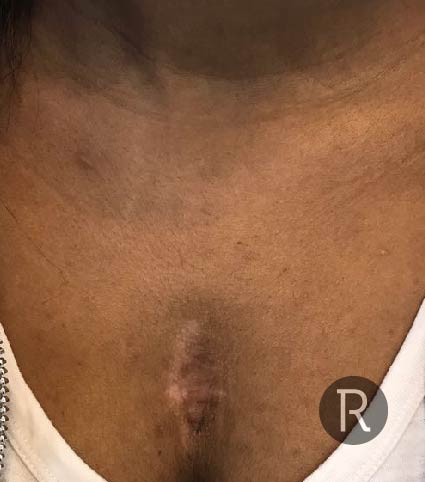
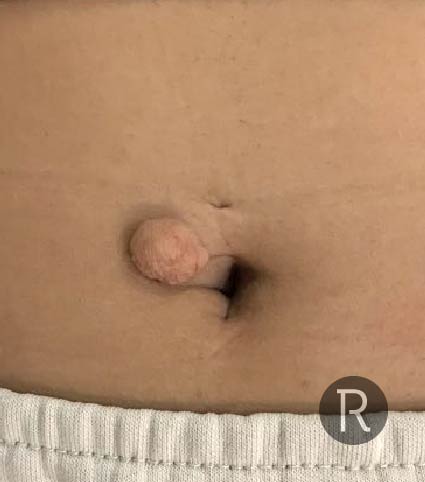
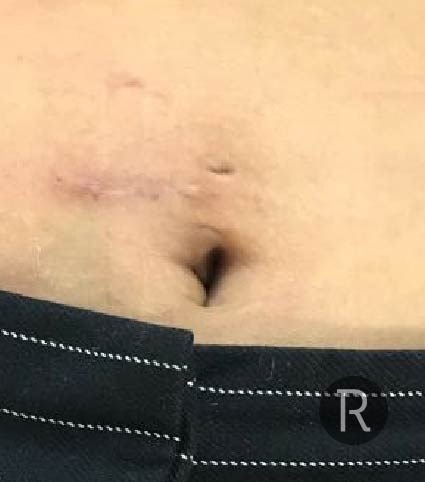
©Individual results may vary.
Realistic Expectations
At Rejuvence Clinic, we have extensive experience in treating keloid scars associated with piercings, especially those occurring on the ear. However, we are now seeing more and more clients presenting to us with keloid scars developing from piercings on the chest and belly button. Using a combination of treatments, and where applicable surgery excellent results can be achieved especially for piercings on the chest wall. In almost all cases should be possible to completely flatten keloid scars. Skin changes such as redness should improve with laser and/or steroid strips. However, it is very important to accept that keloid scars can flare up following successful treatment, and we always advise our patients to keep in touch with the clinic and notify us immediately of any slight flare ups. Early intervention with an intralesional steroid injection can help prevent the keloid scars from recurring and growing to their previous size.
- Steroid Injection – £115 (up to 1ml)
- Steroid Injection – £175 (up to 2mls)
- Steroid Injection – £225 (up to 3mls)
- Steroid Injection w Target Cool – £155 (up to 1ml)
- Steroid Injection w Target Cool – £225 (up to 2ml)
- Steroid Injection w Target Cool – £275 (up to 3ml)
- Flurouracil (5FU) – £165 (per session)
- Flurouracil (5FU) & Steroid Injection – £245 (per session)
- Nd:YAG Laser – from £200 (per session)
- Cryotherapy – £150 (1 ampule) per session
- Cryotherapy w Target Cool – £200 per session
- Surgical Excision – POA
General & Cosmetic Surgery
Afro-Caribbean, South Asian, South American and Hispanic patients are very prone to developing keloid scars following surgery. With an increasing trend towards getting cosmetic surgery abroad in countries such as Turkey and Dominican Republic we are seeing an increasing number of clients presenting to our clinic with Keloid scars following surgery. This is likely due to poor patient counselling with regards to wound care postoperatively and a lack of awareness of the risks of developing keloid scars rather than poor surgical technique.
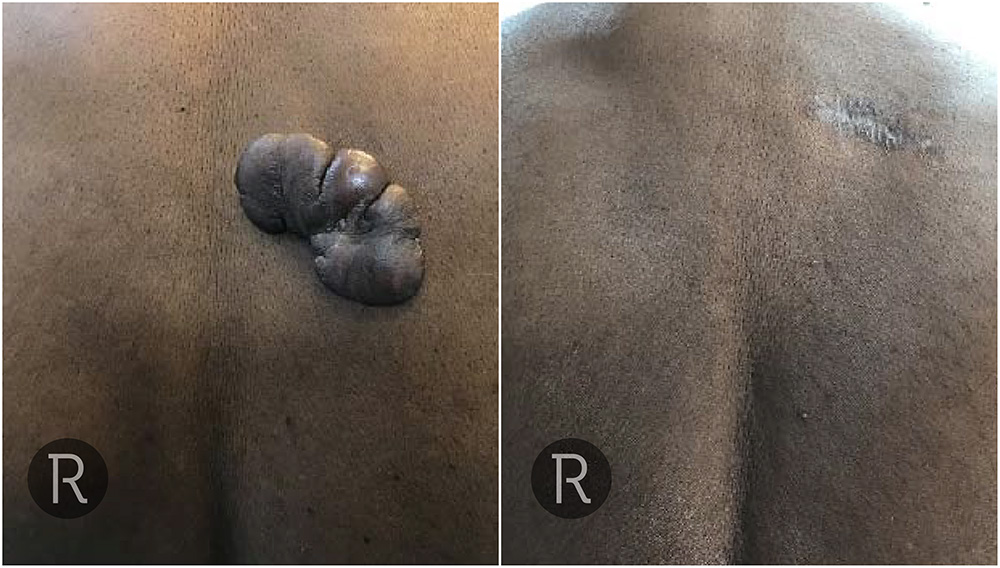
Most of our clients tell us that at the time of their surgery abroad, surgeons did not discuss the importance of using silicon gel and silicon strips to help reduce the risk of developing keloid scars. They also tell us quite often that they were not informed of the increased likelihood of developing keloids due to their ethnic background. Keloid scars are most commonly associated with the following procedures:
- Breast Reduction Surgery – Keloid scars can often develop along the ‘lollipop’ incision line as well as underneath the breast. Keloids can also develop around the areola and become slightly raised. This is especially common in Afro-Caribbean patients. In some cases, keloid scars can also be associated with itching and pain.
- Breast Augmentation Surgery – Hypertrophic, and keloid scars, can often develop along the implant insertion scar just underneath the breast.
- Tummy Tuck Surgery (abdominoplasty) – Keloid scars often develop along the entire breadth of the tummy tuck incision and are particularly thick and wide in the centre just above the pubic region. Often ingrown hairs can develop along the central section of the scar and the keloids are worse following repeated shaving of pubic hairs in this area. Scars can also be very itchy and more rarely associated with pain and increased sensitivity. Patients can also develop keloid scarring around the newly formed belly button following muscle repair. Keloid scars following tummy tuck surgery quite commonly develop in Afro-Caribbean patients, but can also occur in South American and Hispanic ethnic backgrounds as well.
- Liposuction – Aggressive VASER liposuction can result in the development of hypertrophic and keloid scars at the Liposuction entry points, especially on the back and in the groin. In some cases, overaggressive liposuction can result in lipo burns, especially when combined with tummy tuck surgery. In these cases patients can unfortunately develop large and distressing keloid scars due to skin necrosis that can take many months to heal. This can occur in most ethnic backgrounds, but again is more commonly found in Afro-Caribbean, Hispanic and South Asian patients.
- BBL – Following BBL surgery some patients can develop hypertrophic and keloid scars over the fat injection entry port sites. These entry points are usually sited around the buttock. High-risk groups are mainly those of Afro-Caribbean descent.
- C-Section – Asian, South Asian and Afro-Caribbean ethnicities are at increased risk of developing keloid scars from C-section deliveries. In addition to the increased risk of developing keloids generally, the C-section scars are also not normally well looked after. Overtime they can begin to develop into hypertrophic or keloid scars.
- Laparoscopic & Laparotomy Scars – Medically indicated surgical procedures can also result in the development of hypertrophic and keloid scars. These are usually much worse in cases where there is delayed closure, overlying infection, and poor attention to scar care post operatively. The risk of developing keloid scars is greater in darker skin types.
Treatment Options
Ideally, the best form of treatment for keloid scars that develop following cosmetic surgery, is prevention rather than cure. It is extremely important for those patients considering cosmetic surgery, especially if they are from a high risk Keloid forming background (Afro-Caribbean, South Asian or Hispanic), to be fully informed of the risks of developing keloid scars. They should be consulted by their surgeons regarding how they can be prevented with excellent scar care post operatively using compression garments and silicone gel sheets.
Once keloid scars have developed there are a number of treatment options we can provide at Rejuvence Clinic to improve these both in terms of itching and pain as well as their aesthetic appearance. First line treatment includes the use of intralesional steroid injections combined with YAG laser. Keloid scars following cosmetic surgery can vary in terms of their thickness and collagen density, depending on ethnic background, presence of infection and physical pressure and tension working across the scar lines. Patients from Afro-Caribbean backgrounds tend to have much thicker keloid scars, whereas those of a Hispanic and Mediterranean background have keloids that are slightly less dense. The incidence of infections following surgery can result in the development of more inflamed and dense Keloid scars. In addition where large amounts of skin have been removed and the skin closures are much tighter, Keloid scars are more likely. All these factors influence the strength and regularity of intralesional steroid injections as well as YAG laser.
The steroid treatment helps to break down dense scar tissue and improve symptoms such as itching and inflammation. The laser treatment helps to improve the colour of the scar, especially where it is quite red. It is also excellent when it comes to reducing pain. Where scar lines are crossing hair bearing areas specifically in tummy tuck surgery (pubic region), YAG laser can help to eliminate ingrown hairs that may be causing recurrent inflammation. We recommend YAG Laser Hair Removal in the bikini region following treatment to reduce the risk of future flare ups for tummy tuck Keloids. In the case of more stubborn keloids, intralesional chemotherapy injections (5-FU) can help augment the effects of steroids and laser and accelerate scar reduction. Following a course of effective steroid and laser treatments we often start using steroid strips, especially in lighter coloured skin types. Surgical approaches to Keloid scar reduction are not normally recommended due to the high recurrence rates. However, smaller scars commonly found following liposuction procedure can be operated on.

Flexible payment options for surgical treatment – 0% APR available. Spread the cost of your treatment today!
Terms and Conditions apply. *Acceptance subject to credit status.

Flexible payment options for surgical treatment – 0% APR available. Spread the cost of your treatment today!
Terms and Conditions apply. *Acceptance subject to credit status.
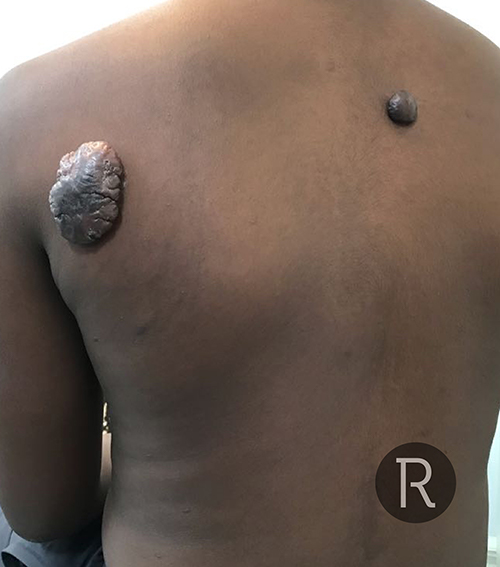
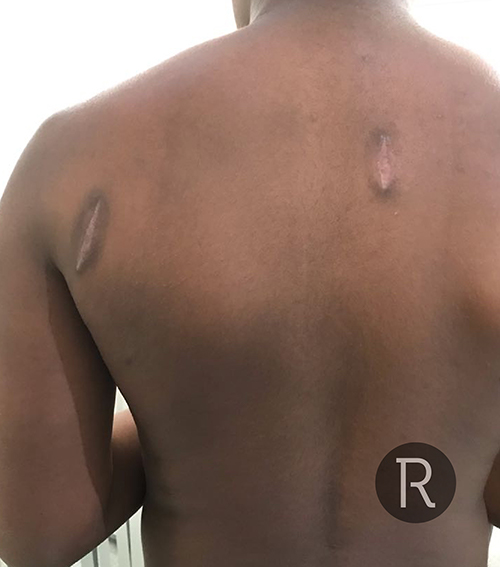
©Individual results may vary.
Side Effects of Treatment
Skin atrophy and hypopigmentation are common side-effects associated with intralesional steroid treatments for Keloid scars. In Afro-Caribbean patients, keloid scars following cosmetic surgery, can be significantly improved using intralesional steroid injections. However, these patients are very susceptible to hypopigmentation (whitening) affecting the scar and the surrounding skin. This is often mitigated by combining treatments with YAG laser that tends to reduce the risk of developing hypopigmentation as well as using tacrolimus ointment on scars that have already lightened in colour. In lighter skin types, especially south Asian and Hispanic patients, treatment with intralesional steroid injections can also have an excellent impact on keloid scars. However, they can be associated with skin atrophy (thinning of the skin) and fat breakdown, resulting in pseudo bruising and dipping or pitting of previously keloid scars. Atrophy can also result in the previously Keloid scar getting slightly wider although flatter. When combined with laser treatment in the same subset of patients, they are at slightly increased risk of sustaining minor burn injuries as well. In Caucasian patients who can also rarely develop keloid scars after cosmetic surgery, intralesional steroid injections can result in telangiectasia (prominent red capillaries become visible through the skin). At Rejuvence Clinic, we have extensive experience in the use of intralesional steroid injections and laser treatments for keloid scars. We mitigate the risk of many of the side-effects by adjusting steroid doses to the ethnic background of the patient, as well as the specific type of cosmetic surgery they have had based on results we have achieved in the past.
Realistic Expectations
At Rejuvence Clinic, we have extensive experience of treating keloid scars, following cosmetic surgery, especially in patients of Afro-Caribbean descent, as well as from other ethnic backgrounds. We understand the differences in response to treatment, as well as the pros and cons of specific combinations in order to achieve optimum results, and reduce the risk of complications. Following treatment with us, you can expect your keloid scar to almost completely flatten with improvements in colour, itching and pain. It is not possible by any means to completely remove such scars though. It is also important to understand that these scars can occasionally flare up in the future despite completing a course of treatments. We encourage all our patients to keep in touch with the clinic and at the first sight of any potential flareup we advise all patients to arrange a review with us with a view to carrying out pre-emptive treatments to prevent the keloids from recurring.
- Steroid Injection – £115 (up to 1ml)
- Steroid Injection – £175 (up to 2mls)
- Steroid Injection – £225 (up to 3mls)
- Steroid Injection w Target Cool – £155 (up to 1ml)
- Steroid Injection w Target Cool – £225 (up to 2ml)
- Steroid Injection w Target Cool – £275 (up to 3ml)
- Flurouracil (5FU) – £165 (per session)
- Flurouracil (5FU) & Steroid Injection – £245 (per session)
- Nd:YAG Laser – from £200 (per session)
- Cryotherapy – £150 (1 ampule) per session
- Cryotherapy w Target Cool – £200 per session
- Surgical Excision – POA













